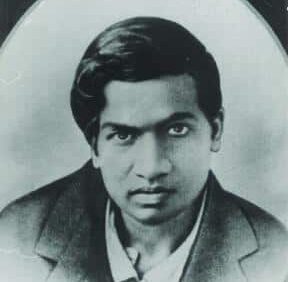Srinivasa Ramanujan was born in 1887 and died at the early age of 32. Despite his short life, he made a number of discoveries in mathematics. In particular, he worked with the partition function and calculated it to many orders beyond what had been done before him.
He came from a poor family and never attended school full-time; however, he was self-educated and borrowed books from local libraries to teach himself mathematics. He was able to solve problems in minutes that would take seasoned mathematicians weeks.
Throughout Ramanujan’s short but remarkable career in mathematics, he compiled nearly 3,900 mathmatical results, mostly identities and equations, which were all independently created through unconventional approaches.
Ramanujan’s genius and unique ways to solve complex mathematical problems originated from lack of formal training, For these reasons, modern estimates place Srinivasa Ramanujan’s IQ score at around 165.
While Ramanujan was clearly a mathematical genius, it is important to realize that an IQ test is made up of multiple components that assess someone’s overall intelligence – not just in mathematics. Because we do not have as much information on Ramanujan’s ability to solve problems in areas like verbal reasoning or spatial awareness, it is necessary to realize that his IQ score of 165 is a rough estimate.
About Srinivasa Ramanujan
Ramanujan’s early work in mathematics in India was eventually identified by other mathematicians around the world. Eventually, he was offered the chance of studying at Cambridge under the great English mathematician Godfrey H. Hardy. On one occasion, Ramanujan entered a mathematics competition held at Cambridge University. Despite his poor health, Ramanujan continued with his mathematical research including several joint works with Hardy.
Ramanujan’s academic career is notable for his contribution to mathematics and, later in life, for his ill health. There are many theories as to the cause of this illness; however, it is generally believed that he contracted tuberculosis which affected his digestive system and would lead to his early death.
By age 11 he was too ill to continue schooling and doctors advised him not to continue with his studies. His early exposure to mathematics created an interest which never left him; despite this advice, he continued his self-education and read as many books as possible on mathematics.
One of his discoveries, published in 1918, was a formula that can be used to calculate the number of distinct prime numbers less than a given number. A mathematical proof for this result was found by German mathematician Jan te Riele more than 70 years later. This result is now known as the “Ramanujan-Hardy” prime number theorem and Ramanujan’s work is considered to be one of the greatest accomplishments in mathematics.
Ramanujan returned to India in 1919, where he died a few years later at age 32. A postage stamp was issued in his honor by the government of India on February 21, 2013, commemorating his 125th birth anniversary.
In 2010, a team of researchers from the University of Hyderabad examined records from Ramanujan’s school and discovered that his IQ may actually have been lower than originally thought by today’s standards.
The record shows that he sat at the bottom of his class and was often punished for not paying attention. However, he had a knack for solving complex problems quickly and easily. Despite poor grades in school, Ramanujan’s mathematical ability was clear from an early age. His performance at school may have been directly related to his overall health problems.
A stamp was issued in his honor by the Indian government on February 21, 2013. The stamp shows an illustration of Ramanujan’s face and formulas that he used to describe some mathematical results.
Image credit:
Konrad Jacobs, CC BY-SA 2.0 DE, via Wikimedia Commons
